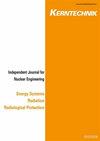GRS对欧洲流动诱发振动相关活动的贡献
IF 0.4
4区 工程技术
Q4 NUCLEAR SCIENCE & TECHNOLOGY
引用次数: 0
摘要
核电厂的流激振动可能导致材料疲劳、微动磨损,并最终导致部件的完整性丧失。其后果可能是由于长时间的计划外中断或需要按预期执行安全措施的故障而造成的巨大成本。为了避免这些,流体-结构相互作用分析被用来理解和预测复杂的热-水力和结构力学现象。为了进一步提高在数值工具的帮助下解决FSI问题的知识,在2020年初,欧洲建立了联合行业VIKING项目。此外,OECD/NEA于2021年启动了FIV的FSI基准,该基准应于2022年底完成,最终综合报告应于2023年发布。本文简要概述了GRS在这两项国际活动中对核动力反应堆FIV预测的贡献。本文的内容最初是在3月22日至23日在德国Garching GRS举行的第33届德国CFD网络能力会议上提出的。本文章由计算机程序翻译,如有差异,请以英文原文为准。
GRS contributions to flow-induced vibrations related activities in Europe
Abstract Flow-induced vibrations in nuclear power plants may lead to material fatigue, fretting wear, and eventually to loss of component integrity. The consequences might be substantial costs due to long unplanned outages or a fault that requires safety provisions to perform as intended. To avoid these, Fluid-Structure Interaction analyses are performed to understand and predict the complex thermal-hydraulic and structural mechanics phenomena. To further advance the knowledge of solving FSI problems with the help of numerical tools, in the beginning of 2020, the joint industry VIKING project was established in Europe. Further, OECD/NEA initiated in 2021 an FSI Benchmark on FIV that should be finished by the end of 2022 and the final synthesis report should be published in 2023. This paper provides a short overview of the GRS contributions within these two international activities on the prediction of FIV in nuclear power reactors. The content of this article was initially presented at the 33rd German CFD Network of Competence Meeting, held on March 22–23 at GRS in Garching, Germany.
求助全文
通过发布文献求助,成功后即可免费获取论文全文。
去求助
来源期刊

Kerntechnik
工程技术-核科学技术
CiteScore
0.90
自引率
20.00%
发文量
72
审稿时长
6-12 weeks
期刊介绍:
Kerntechnik is an independent journal for nuclear engineering (including design, operation, safety and economics of nuclear power stations, research reactors and simulators), energy systems, radiation (ionizing radiation in industry, medicine and research) and radiological protection (biological effects of ionizing radiation, the system of protection for occupational, medical and public exposures, the assessment of doses, operational protection and safety programs, management of radioactive wastes, decommissioning and regulatory requirements).
 求助内容:
求助内容: 应助结果提醒方式:
应助结果提醒方式:


